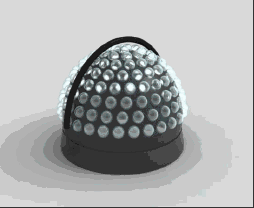Dragonfly eye inspired solar collector design
 Unknown South Korean inventor Jong-Eun Lee made headlines worldwide this week when he received a patent in near-record time for his solar invention inspired by dragonfly eyes.
Unknown South Korean inventor Jong-Eun Lee made headlines worldwide this week when he received a patent in near-record time for his solar invention inspired by dragonfly eyes.
Lee offered an exclusive interview to CleanEnergyAuthority.com.
Lee trains homebuilders in how to construct traditional Korean homes and attended the Clean Energy Summit in Las Vegas last year.
After that event, which until then represented most of his experience with solar, he spent a lot of time thinking about the most rational way to harness the sun’s power, he said through a translator.
“A dragonfly’s eye consists of over 20,000 ball-type lenses in one big ball and it can see from over 300 degree angles,” Lee said. “To see means to collect light and this is common sense which everyone unconsciously already knows. If a dragonfly can collect light with its peculiar multiple ball-type lenses, why can we not do it? That is what inspired me.”
His invention uses mirrors in multiple raised circles coming off a larger ball. The mirrors heat salt and store energy in that molten salt the same way concentrated solar power dishes and troughs do. The difference is that the concentration is greater and more compact in Lee’s configuration, which will allow his solar dragonfly eyes to produce more power using less space.
“Why haven’t all the scientist and energy experts found this simple principle?” Lee wonders. “But the reason why is that I think we human beings have been trained to think only one way fashion. For an example, one of the most efficiently used inventions in this modern age is Velcro closure where someone got an idea from a thistle in the bush. Very simple, but one had never paid attention to it until it actually came out to the market.”
He said the same is true for Newton’s theory of gravity.
“Apples have been falling all throughout the human history,” Lee said. “But it was Newton who found it and we are reaping the benefit of his simple discovery.”
He said the efficiency of the invention is more than 100 times greater than the efficiency of any existing solar technology and that he’s already fielding requests from companies throughout the world.
He expects to release a prototype for display by the end of April and will offer the technology to other companies that will be able to carry it to commercialization.



